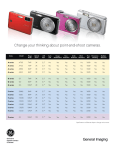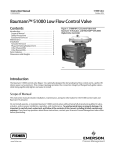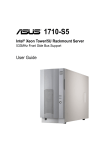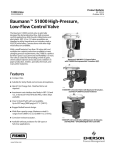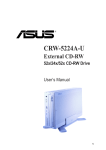Download Asus 5U Tower Chassis Kit AK35 User guide
Transcript
AK35 5U Tower Chassis Kit User Guide Disclaimer/Copyrights Copyright © 2003 ASUSTeK COMPUTER INC. All Rights Reserved. No part of this manual, including the products and software described in it, may be reproduced, transmitted, transcribed, stored in a retrieval system, or translated into any language in any form or by any means, except documentation kept by the purchaser for backup purposes, without the express written permission of ASUSTeK COMPUTER INC. (“ASUS”). ASUS provides this manual “as is” without warranty of any kind, either express or implied, including but not limited to the implied warranties or conditions of merchantability or fitness for a particular purpose. In no event shall ASUS, its directors, officers, employees, or agents be liable for any indirect, special, incidental, or consequential damages (including damages for loss of profits, loss of business, loss of use or data, interruption of business and the like), even if ASUS has been advised of the possibility of such damages arising from any defect or error in this manual or product. Specifications and information contained in this manual ae furnished for informational use only, and are subject to change at any time without notice, and should not be construed as a commitment by ASUS. ASUS assumes no responsibility or liability for any errors or inaccuracies that may appear in this manual, including the products and software described in it. Product warranty or service will not be extended if: (1) the product is repaired, modified or altered, unless such repair, modification of alteration is authorized in writing by ASUS; or (2) the serial number of the product is defaced or missing. Products and corporate names appearing in this manual may or may not be registered trademarks or copyrights of their respective companies, and are used only for identification or explanation and to the owners’ benefit, without intent to infringe. Product Name: Manual Edition: Release Date: ii ASUS AK35 Revised edition V2 (E1235) May 2003 Contents Disclaimer/Copyrights ..................................................................... ii Contents ......................................................................................... iii Notices ............................................................................................ v Safety information .......................................................................... vi About this guide ............................................................................. vii ASUS Contact Information ........................................................... viii Chapter 1: Product introduction ......................................... 1-1 1.1 1.2 1.3 1.4 1.5 1.6 Package contents ............................................................... 1-2 1.1.1 ASUS AK35 chassis kit .......................................... 1-2 1.1.2 Standard items ....................................................... 1-2 1.1.3 Optional items ........................................................ 1-2 System overview ................................................................ 1-3 Front panel features ........................................................... 1-4 Rear panel features ............................................................ 1-5 Internal features ................................................................. 1-6 LED information .................................................................. 1-7 Chapter 2: Hardware setup .................................................. 2-1 2.1 2.2 2.3 2.4 2.5 Preparation ......................................................................... 2-2 2.1.1 Tools to use ............................................................ 2-2 2.1.2 System components and devices to install ............ 2-2 Removing and installing the side cover .............................. 2-3 2.2.1 Removing the cover ............................................... 2-3 2.2.2 Installing the cover ................................................. 2-3 Motherboard installation ..................................................... 2-4 2.3.1 Motherboard dimensions ....................................... 2-4 2.3.2 Placement direction and screw holes .................... 2-5 2.3.3 Installing the motherboard ..................................... 2-6 Installing 5.25-inch drives ................................................... 2-7 2.4.1 Removing the front panel assembly ...................... 2-7 2.4.2 Installing a 5.25-inch drive ..................................... 2-8 Installing hard disk drives ................................................. 2-12 2.5.1 SCSI hard disk ..................................................... 2-12 2.5.2 IDE hard disk ....................................................... 2-14 iii Contents 2.6 2.7 2.8 Installing or removing an expansion card ......................... 2-16 2.6.1 Installing a standard size expansion card ............ 2-16 2.6.2 Installing a long expansion card .......................... 2-18 2.6.3 Removing an expansion card .............................. 2-19 Removable components ................................................... 2-20 2.7.1 HDD blower ......................................................... 2-20 2.7.2 Chassis fan .......................................................... 2-21 2.7.3 Roller wheels ....................................................... 2-22 2.7.4 Power supply modules ......................................... 2-23 Connecting the cables ...................................................... 2-24 2.8.1 Motherboard connections .................................... 2-24 2.8.2 SCSI backplane connections ............................... 2-25 Appendix: Troubleshooting ..................................................A-1 A.1 Simple fixes ........................................................................ A-2 iv Notices Federal Communications Commission Statement This device complies with FCC Rules Part 15. Operation is subject to the following two conditions: • This device may not cause harmful interference, and • This device must accept any interference received including interference that may cause undesired operation. This equipment has been tested and found to comply with the limits for a Class B digital device, pursuant to Part 15 of the FCC Rules. These limits are designed to provide reasonable protection against harmful interference in a residential installation. This equipment generates, uses and can radiate radio frequency energy and, if not installed and used in accordance with manufacturer’s instructions, may cause harmful interference to radio communications. However, there is no guarantee that interference will not occur in a particular installation. If this equipment does cause harmful interference to radio or television reception, which can be determined by turning the equipment off and on, the user is encouraged to try to correct the interference by one or more of the following measures: • Reorient or relocate the receiving antenna. • Increase the separation between the equipment and receiver. • Connect the equipment to an outlet on a circuit different from that to which the receiver is connected. • Consult the dealer or an experienced radio/TV technician for help. WARNING! The use of shielded cables for connection of the monitor to the graphics card is required to assure compliance with FCC regulations. Changes or modifications to this unit not expressly approved by the party responsible for compliance could void the user’s authority to operate this equipment. Canadian Department of Communications Statement This digital apparatus does not exceed the Class B limits for radio noise emissions from digital apparatus set out in the Radio Interference Regulations of the Canadian Department of Communications. This class B digital apparatus complies with Canadian ICES-003. v Safety information Electrical Safety IMPORTANT • Before installing or removing signal cables, ensure that the power cables for the system unit and all attached devices are unplugged. • To prevent electrical shock hazard, disconnect the power cable from the electrical outlet before relocating the system. • When adding or removing any additional devices to or from the system, ensure that the power cables for the devices are unplugged before the signal cables are connected. If possible, disconnect all power cables from the existing system before you add a device. • If the power supply is broken, do not try to fix it by yourself. Contact a qualified service technician or your dealer. CAUTION This product is equipped with a three-wire power cable and plug for the user’s safety. Use the power cable with a properly grounded electrical outlet to avoid electrical shock. Operation Safety IMPORTANT vi • Any mechanical operation on this server must be conducted by certified or experienced engineers. • Before operating the server, carefully read all the manuals included with the server package. • Before using the server, make sure all cables are correctly connected and the power cables are not damaged. If any damage is detected, contact your dealer as soon as possible. • To avoid short circuits, keep paper clips, screws, and staples away from connectors, slots, sockets and circuitry. • Avoid dust, humidity, and temperature extremes. Place the server on a stable surface. About this guide Audience This user guide is intended for system integrators, and experienced users with at least basic knowledge of configuring a server. Contents This guide contains the following parts: 1. Chapter 1: System overview This chapter describes the general features of the AK35 barebone server. It includes sections on front panel and rear panel specifications. 2. Chapter 2: Hardware setup This chapter lists the hardware setup procedures that you have to perform when installing system components. 3. Appendix: Troubleshooting This appendix lists the common problems that you may encounter while using the AK35 barebone server. It lists the possible causes of the problems and offers solutions. You may refer to this part and try to solve simple problems before calling customer support. Conventions To make sure that you perform certain tasks properly, take note of the following symbols used throughout this manual. WARNING: Information to prevent injury to yourself when trying to complete a task. CAUTION: Information to prevent damage to the components when trying to complete a task. IMPORTANT: Information that you MUST follow to complete a task. NOTE: Tips and information to aid in completing a task. vii ASUS Contact Information ASUSTeK COMPUTER INC. (Asia-Pacific) Address: General Tel: General Fax: General Email: 150 Li-Te Road, Peitou, Taipei, Taiwan 112 +886-2-2894-3447 +886-2-2894-3449 [email protected] Technical Support MB/Others (Tel): Notebook (Tel): Desktop/Server (Tel): Support Fax: Web Site: +886-2-2890-7121 (English) +886-2-2890-7122 (English) +886-2-2890-7123 (English) +886-2-2890-7698 www.asus.com.tw ASUS COMPUTER INTERNATIONAL (America) Address: General Fax: General Email: 44370 Nobel Drive, Fremont, CA 94538, USA +1-510-608-4555 [email protected] Technical Support Support Fax: General Support: Web Site: Support Email: +1-510-608-4555 +1-502-933-8713 www.asus.com [email protected] ASUS COMPUTER GmbH (Germany and Austria) Address: General Email: General Fax: Harkortstr. 25, 40880 Ratingen, BRD, Germany [email protected] (for marketing requests only) +49-2102-9599-31 Technical Support Support Hotline: Support (Email): Web Site: Support Fax: viii Components: +49-2102-9599-00 Notebook PC: +49-2102-9599-10 www.asuscom.de/kontakt (for online support) www.asuscom.de +49-2102-9599-11 This chapter describes the general features of the AK35 chassis kit. It includes sections on front panel, rear panel, and internal features. ASUS AK35 chassis kit Product introduction Chapter 1 1-1 1.1 Package contents 1.1.1 ASUS AK35 chassis kit The AK35 models are distinguished by the type of bundled HDD tray and power supply. Refer to the following table to check the items that came with the model you purchased. Model AK35-SR5 AK35-SS4 AK35-SS3 AK35-AR5 AK35-AR4 AK35-AR3 HDD tray type SCSI SCSI SCSI ATA ATA ATA Power supply unit(s) 500W redundant (2 units) 450W single 320W single 500W redundant (2 units) 450W single 320W single 1.1.2 Standard items 1. Chassis kit including: • power supply unit(s) • SCSI backplane board • CD-ROM drive • floppy disk drive • hot-swap HDD trays (6 units) • SCSI-IDE HDD bridge board (6 units) • chassis fan • chassis roller wheels 2. Cables • 6-pin SMBus cable • BP-LED cable • internal SCSI cable • external SCSI cable • chassis intrusion cable • power cable 3. Component screws 4. ASUS AK35 Chassis Kit User Guide 1.1.3 Optional item • ASUS AK35 5U Rackmount Rail Kit If any of the above items is damaged or missing, contact your retailer. 1-2 Chapter 1: Product introduction 1.2 Overview The AK35 chassis kit is designed for easy configuration, flexibility, and high reliability. The chassis may be set up as standalone or rack-mount. Flexible expansion Front panel Inside the stylish front bezel secured by a lock, the front panel features easily accessible drives bays: • a floppy drive bay (floppy drive already installed) • three 5.25-inch bays (one occupied by a CD-ROM drive) • six 3.5-inch hard disk drive bays with externally removable trays On the rear panel are slots for seven full-length expansion cards, a slot for the motherboard rear panel I/O, and a bay for two redundant power supply modules or a standard power supply module. Rear panel A slot for an external SCSI interface is also available. Strategic interior Inside the chassis, the SCSI backplane is installed and the appropriate cables routed. The drive and fan cages are strategically placed to ensure proper system ventilation and easy installation of components. A plastic long-card support is provided to stabilize and hold long expansion cards in place. The chassis supports an extended ATX form factor ASUS motherboards. See the motherboard dimension requirements on page 2-4. Refer to the succeeding sections for a brief description of the basic components that are pre-installed in the chassis. ASUS AK35 chassis kit 1-3 1.3 Front panel features The AK35 chassis kit displays a stylish front bezel with lock. The bezel covers the system components on the front panel and serves as security. Open the bezel to access the front panel components. The front panel is designed to allow convenient access to the hard disk drives and other external features. The power and reset buttons, LED indicators, CD-ROM drive, floppy drive, and two USB ports are also located on the front panel. For future installation of 5.25 devices, two drive bays are available. Security lock CD-ROM drive Floppy disk drive 2 empty 5.25-inch bays Reset button Power button Power LED HDD access LED Message LED 6 HDD Hot-swap trays Detachable front panel cover USB ports 1-4 Chapter 1: Product introduction 1.4 Rear panel features The rear panel includes a slot for the motherboard rear I/O ports, seven full-length expansion slots, a chassis lock and intrusion switch, a vent for the system fan, and either two redundant power supply modules or a standard power supply module. System with redundant power supply modules AC IN socket (110V/220V autoswitching) Redundant power supply modules Slot for motherboard rear panel I/O AC Power LED 12cm fan vent Chassis lock Expansion slots Chassis intrusion switch (underneath) High density 68-pin SCSI connector System with standard power supply module Standard power supply module AC IN socket (110V/220V autoswitching) ASUS AK35 chassis kit 1-5 1.5 Internal features The chassis kit includes the basic components as shown in the picture below. The power supply area differs depending on the power supply module that came with the server you purchased. System with standard power supply module 2 1 3 8 7 4 5 6 1. 2. 3. 4. 5. 6. 7. 8. Power supply module 5.25-inch drive cage SCSI backplane board 3.5-inch external drive cage 12-cm hard drive blower Plastic long-card support Motherboard metal plate Chassis fan System with redundant power supply modules The picture below shows a system redundant power supply modules. All other basic system components are the same as the above picture. 1 1-6 Chapter 1: Product introduction 1.6 LED information The following table describes the LED indicators on the server front and rear panels. LED Drive Status LED Status Description Green Installed HDD is in good condition; supplied power is sufficient Red HDD fails Blinking red HDD is rebuilding using the RAID card SCSI Access Fault-Tolerant Enclosure (SAFTE) Drive Activity LED Blinking HDD read/write data Power LED ON System power ON Blinking Suspend mode OFF No activity Blinking Read/write data into the HDD OFF Normal; no incoming event Blinking ASMS indicates a HW monitor event Redundant power ON System power supply is ON module LED OFF System power supply is OFF HDD Access LED Message LED ASUS AK35 chassis kit 1-7 1-8 Chapter 1: Product introduction Chapter 2 Hardware setup This chapter describes the internal hardware components and provides the installation procedures for additional system components. ASUS AK35 chassis kit 2-1 2.1 Preparation Before proceeding, prepare everything that you might need to facilitate installation. 2.1.1 Tools to use 1. Phillips head screw driver 2. Flat head screw driver 2.1.2 System components and devices to install The following items are the basics that you need to install into the chassis kit. You may need to install other devices depending on your configuration. 1. 2. 3. 4. 2-2 Motherboard Hard disk drives Drive cables PCI add-on cards Chapter 2: Hardware setup 2.2 Removing and installing the side cover 2.2.1 Removing the cover 1. Loosen the two thumb screws that secure the side cover. 2. Slide the side cover for about half an inch toward the rear until it is disengaged from the chassis. 1 2 2.2.2 Installing the cover 1. Match and insert the hooks of the cover to the elongated holes on the side of the chassis. All the six hooks (three each on the top and bottom) of the cover must properly fit the designated holes. 2. Slide the cover toward the front until it snaps in place. 3. Tighten the thumb screws to secure the cover. Hole on the side of the chassis Hook on the cover 1 3 2 ASUS AK35 chassis kit 2-3 2.3 Motherboard installation This section only describes how to install a supported motherboard into the AK35 chassis kit. Refer to the motherboard user guide for instructions on installing specific motherboard components. 2.3.1 Motherboard dimensions 12 in (30.5 cm) This chassis kit supports an ASUS motherboard that measures 12x13 inches (30.5 x 33 cm) for SCSI models, or 12x12 inches (30.5 x 30.5 cm) for IDE models. Motherboards of smaller sizes will fit into the system chassis. Refer to the motherboard user guide for more information on the system requirements. 13 in (33 cm) Make sure that the motherboard you intend to install into the chassis does not exceed the maximum specified dimensions. Otherwise, it will not fit into the chassis. 2-4 Chapter 2: Hardware setup 2.3.2 Placement direction and screw holes Align the holes on the motherboard (indicated by white circles in the picture below) to the corresponding standoffs on the motherboard metal plate inside the chassis. Place screws through the designated holes to secure the motherboard to the chassis. Refer to the motherboard user guide for the specific number of screws that you need to use. Place this side (with I/O ports) to the rear side of the chassis The following figure shows the specific locations of the standoffs (indicated by black circles) inside the chassis. These standoffs should match with the holes on the motherboard as pointed out above. Metal plate Standoff ASUS AK35 chassis kit 2-5 2.3.3 Installing the motherboard 1. Remove the temporary metal shield on the rear panel (beside the chassis fan) that covers the rear I/O slot opening. 2. Install the rear I/O shield that came with the motherboard package. Orient the I/O shield such that the openings for the mouse and keyboard ports are aligned to the top of the chassis fan. 1 Temporary metal shield on the I/O slot opening Mouse/Keyboard port openings 2 I/O shield 3. Position the I/O side of the motherboard toward the chassis rear panel, matching the I/O ports to the openings on the I/O shield. 4. Secure the motherboard with 11 screws through the holes indicated in section 2.3.2. 2-6 3 Chapter 2: Hardware setup 2.4 Installing 5.25-inch drives If you have previously used and powered up the system, and that it may be connected to an AC power source, make sure to unplug the power cable before installing or removing any system components. Failure to do so may cause severe damage to the motherboard and other system components! Three 5.25-inch drive bays are located on the upper front part of the chassis. A CD-ROM drive that comes standard with the system package occupies the uppermost bay (labeled 1). The two lower bays (labeled 2 and 3) are available for additional 5.25-inch devices. 1 2 3 2.4.1 Removing the front panel assembly Before you can install a 5.25-inch drive, you should first remove the front panel assembly (front bezel and front panel cover). The front panel assembly is attached to the chassis through four hooked tabs on the left side and four hinge-like tabs on the right side. To remove the front panel assembly: 1. Use a flat-head screwdriver to detach the hooked tabs from the left side of the front panel. 1 Hooked tab ASUS AK35 chassis kit 2-7 2. Pull and swing the left edge of the front panel outward. 3. Unhook the hinge-like tabs from the holes on the right side of the front panel to completely detach the front panel assembly from the chassis. 3 Hinge-like tab 2 2.4.2 Installing a 5.25-inch drive To install a 5.25-inch drive: 1. Remove the metal cover of the bay where you wish to install the drive by pulling the cover outward. 1 2-8 Chapter 2: Hardware setup 2. From the side of the drive bay, unlock and remove the screwless drive bay lock by turning the knob 45º counter-clockwise until it clicks on the reference point near the “unlocked icon.” Reference point 2 Unlocked icon Knob 3. When released, pull out the drive bay lock and set it aside. 3 4. Carefully insert a 5.25-inch drive (such as a CD/DVDROM drive) into the bay until it is in place. 4 The drive is in place when the screw holes on the drive align with the holes on the side of the bay. ASUS AK35 chassis kit 2-9 5. Secure the drive to the bay using the screwless drive bay lock that you removed earlier. a. Match the two pegs on the lock to the holes on the drive bay. b. Turn the knob 45º clockwise until it clicks on the reference point near the “locked icon.” 5a Reference point 5b Locked icon 6. On the front panel assembly, detach the plastic bay cover opposite the 5.25-inch drive that you installed by pressing the two hooked tabs on each side of the bay cover. 6 Bay cover tabs 2-10 Chapter 2: Hardware setup 7. Re-install the front panel assembly (front bezel and front panel cover). a. Insert the four hinge-like tabs to the holes on the right edge of the chassis. b. Swing the front panel to the left and fit the four (4) hooked tabs to the left side of the chassis until the tabs snap in place. 7a 7b ASUS AK35 chassis kit Hinge-like tab 2-11 2.5 Installing hard disk drives The six hard disk drive (HDD) bays on the front panel include externally removable trays for mounting either SCSI or IDE 3.5-inch hard disk drives. You can access the drive trays by simply opening the the front bezel. 1. SCSI and IDE drive trays differ in size and structure. Make sure of the type of HDD trays that came with your chassis before buying hard disks. 2. If your motherboard does not have an onboard SCSI interface, you need to install a SCSI expansion card into one of the PCI slots. Use a SCSI cable to connect the card to the SCSI backplane board to which the hard disks are connected. 2.5.1 SCSI hard disk To install a SCSI hard disk drive: 1. Release an HDD tray by pushing the tray lock upward 2. Pull down the tray lever until the tray pops out slightly, indicating that it is released. 2 1 Tray lock Tray lever 3. Holding on the tray lever, pull out the HDD tray from the bay. 3 2-12 Chapter 2: Hardware setup 4. Place a hard disk drive on the tray and secure it with four screws. 4 5. Insert the tray with the installed HDD back into the bay. Make sure to place the tray in the correct orientation as shown. 6. Carefully push the tray all the way to the depth of the bay. 7. Push the tray lever until it clicks in place. The drive tray is correctly placed when its front edge aligns with the bay edge. 7 6 The edge of the tray protrudes about 0.5 cm until you push back the tray lever. ASUS AK35 chassis kit 2-13 2.5.2 IDE hard disk To install an IDE hard disk drive: 1. Place the hard disk tray on a flat clean surface. Rear bracket Middle bracket 1 Drive tray rail 2. Use a Phillips screwdriver to remove the screw that secures the middle bracket from the drive tray. 3. Remove that screw that secures the rear bracket to detach it from the drive tray. 2 3 Be careful when handling the drive tray rails to avoid breaking them. 2-14 Chapter 2: Hardware setup 4. Prepare hard disk drive. Carefully connect the SCSI-IDE HDD bridge board to the 40-1 pin IDE connector and 4-pin power connector. Make sure that the SCSI-IDE HDD bridge is properly connected. 4 SCSI-IDE HDD bridge board 5. Carefully place the hard disk drive into the drive tray. Align the four (4) screw holes on the drive with those on the tray rails. Secure drive with four round head screws. 6. Secure the SCSI-IDE HDD Bridge to the tray with two (2) round head screws. 7. Re-attach the rear bracket and secure it with two (2) flat head screws. 6 5 7 Do not overtighten the screws to avoid breaking the plastic tray rails. 8. To install the tray into the bay, follow steps 5, 6, and 7 in section 2.5.1. ASUS AK35 chassis kit 2-15 2.6 Installing or removing an expansion card The chassis is designed with a screwless expansion slot frame on the rear panel. This design feature allows you to install or remove an expansion card in less steps. Make sure to unplug the power cord before installing or removing expansion cards. Failure to do so may cause physical injury, and damage to the card and motheboard components! 2.6.1 Installing a standard size expansion card To install an expansion card: 1. Release the card lock. a. Press the card lock lever. b. The card lock flips up. Card lock lever Card lock 1a 2. Slide out the metal bracket opposite the PCI slot where you wish to install the expansion card. You may use a flat-head screwdriver to easily remove the bracket. 2-16 1b 2 Chapter 2: Hardware setup 3. Install the expansion card making sure that it is properly seated on the slot. 3 LOCK 4. Press the end of the card lock marked “LOCK” to secure the card on the slot. A light click indicates that the card is locked in place. 4 Refer to the card documentation for the card configuration details, and to the motherboard user guide in case you need to configure any jumpers after installing the expansion card. ASUS AK35 chassis kit 2-17 2.6.2 Installing a long expansion card If you are installing a long expansion card, such as some types of RAID cards, use the plastic card support located near the front of the chassis (under the backplane board) to keep the expansion cards firmly seated on the slots. This card support has individual card guides that correspond to each expansion slot. Plastic long-card support To install a long expansion card: 1. Position the expansion card above the PCI slot that you wish to use. 2. Insert one end of the card to the card guide opposite the PCI slot, and align the bracket end of the card to the expansion slot on the rear panel. 3. Slide in the card down until it is properly seated on the slot. 4. Secure the card using the screwless lock on the card guide. Screwless lock 2-18 Chapter 2: Hardware setup 2.6.3 Removing an expansion card To remove an expansion card: 1. Release the card lock. a. Press the card lock lever. b. The card lock flips up. Card lock lever Card lock 1a 1b 2. Pull out the card from the PCI slot. 2 3. Press the end of the card lock marked “LOCK” to return it in place. ASUS AK35 chassis kit 2-19 2.7 Removable components When installing or removing system devices, you may need to remove previously installed components. This section describes how to remove these components. 2.7.1 HDD blower To remove the HDD blower: 1. Disconnect the 3-pin HDD blower cable from the FAN 1 connector on the SCSI backplane. 1 HDD blower cable HDD blower 2. Press the tab at the bottom of the blower to release it from the chassis. 3. Pull out the HDD blower. 3 2 Blower tab HDD blower 2-20 Chapter 2: Hardware setup 2.7.2 Chassis fan To remove the 12-cm chassis fan: 1. Disconnect the 3-pin fan cable from the connector on the motherboard. 2. Use a flat screwdriver to push the pin locks on the four corners of the fan from the inside of the chassis. Chassis fan cable Pin lock (tail-end) 3. Pull out the pin locks from the rear panel. 4. Remove the chassis fan. Pin lock ASUS AK35 chassis kit 2-21 2.7.3 Roller wheels The chassis comes with four roller wheels for convenient transport. Each wheel has a brake lock to stabilize the chassis in place. To remove the chassis wheels: 1. Lay the chassis in its side. 2. Use a Phillips screwdriver to remove the screws that secure the wheels to the bottom of the chassis. Brake lock Remove the chassis roller wheels if you wish to mount the system to a rack. Refer to the Rackmount Kit manual for more information. 2-22 Chapter 2: Hardware setup 2.7.4 Power supply modules The redundant power model has two power supply modules. These hot swap power modules can be removed or installed while the system is powered ON. Only one power module is necessary to provide power to the system. However, it is recommended to have two redundant power supply modules. In case one of the power modules fails, the other one keeps providing sufficient power to the system. This eliminates system down time and data loss. When two power supply modules are installed, the task of providing power to the server is shared. To remove the redundant power supply module: 1. Remove the screw that secures the power module to the chassis. 2. Press down the rubber lever to release the power module. 3. Pull out the power module from the chassis. 1 2 3 500W Redundant Power Module ASUS AK35 chassis kit 2-23 2.8 Connecting the cables 2.8.1 Motherboard connections The chassis includes power and signal cables that you need to connect to the motherboard, SCSI backplane, and to the devices that you will install. Most of the cables for the chassis kit are already connected upon shipment. When installing system devices and connecting cables, make sure that all cables are routed properly for better system stability and performance. Refer to the picture below when arranging cables. 1 2 3 4 6 5 11 7 8 10 12 9 Standard cables connected to the motherboard 1. Chassis fan 7. SMBus panel to backplane 2. 12V AUX power 8. Floppy disk drive 3. 24-pin ATX power 9. System front panel 4. Primary IDE 10. External SCSI 5. Secondary IDE 11. 6. SCSI backplane 12. Front USB HDD access Refer to the motheboard user guide for detailed information on the connectors. 2-24 Chapter 2: Hardware setup 2.8.2 SCSI backplane connections The SCSI backplane has six 68-pin SCSI connectors to support SCA SCSI hard disks. The backplane design incorporates a hot-swap feature to allow easy connection or removal of SCSI hard disks. The LED connectors on the backplane connect to the front panel LEDs to indicate HDD access, HDD failure, thermal failure, or fan failure. Front side Fan connectors Power connectors (connects power plugs from the power supply) 68-pin SCSI connector (connect to the SCSI connector on the motherboard) SMBus connector SMBus connector (connect to the SMBus connector on the motherboard) (connects the 6-pin plug from the power supply) HDD Access LED (connect to the HDD LED connector on the motherboard) Back side HDD status LEDs SCSI ID = 0 Disk drive 1 SCSI ID = 1 Disk drive 2 SCSI ID = 2 Disk drive 3 SCSI ID = 3 Disk drive 4 SCSI ID = 4 Disk drive 5 SCSI ID = 5 Disk drive 6 ASUS AK35 chassis kit HDD activity LEDs 2-25 The following picture shows the SCSI backplane installed in the system and the cables connected to it. Fan cables Power plugs from the power supply SCSI cable LED cables To ensure power redundancy, it is recommended that you use power plugs from each of the redundant power supply modules. 2-26 Chapter 2: Hardware setup This appendix lists the common problems that you may encounter while using the server. It lists the possible causes of the problems and offers solutions. You may refer to this part and try to solve simple problems before calling customer support. ASUS AK35 chassis kit Troubleshooting Appendix A-1 A.1 Simple fixes Some problems that you may encounter are not due to defects on the system or the components. These problems only requires simple troubleshooting actions that you can perform by yourself. Problem A-2 Action The power LED on the server or on the monitor do not light up 1. Check the power cable connection on the system rear panel if properly connected. 2. Make sure that the power cables are connected to a grounded power outlet. The keyboard does not work Check the keyboard cable if properly connected to the keyboard port. The mouse does not work Check the mouse cable if properly connected to the mouse port. The system does not perform power-on self tests (POST) after it was turned on 1. Check the memory modules and make sure you installed the DIMMs the system supports. 2. Make sure that the DIMMs are properly installed on the sockets. Appendix: Troubleshooting Problem Action The system continuously beeps after it was turned on 1. Check the memory modules and make sure you installed the DIMMs the system supports. 2. Make sure that the DIMMs are properly installed on the sockets. 3. Check if it has a VGA ouput. The message “Non-system disk or disk error” appears 1. Check if a bootable HDD is active. 2. Check if the HDDs are properly installed. On SCSI models, make sure that the cables are properly connected to the SCSI connectors on the backplane. Network connection not available 1. Make sure that the network cable is connected to the RJ-45 port on the rear panel. 2. Make sure that you have installed the LAN drivers from the support CD. ASUS AK35 chassis kit A-3 A-4 Appendix: Troubleshooting














































